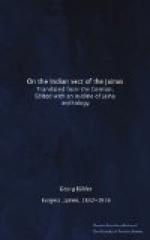To each of these is allotted twenty four past, present and future Atits or Jinas,—making in all 720 of this class, for which they have invented names: but they are only names. [Footnote: See Ratnasagara, bh. II, pp. 696—705.]
Of the Tirthakaras of the present age or avasarpini in the Bharata-varsha of Jambudvipa, however, we are supplied with minute details:—their names, parents, stations, reputed ages, complexions, attendants, cognizances (chihna) or characteristics, etc. and these details are useful for the explanation of the iconography we meet with in the shrines of Jaina temples. There the images of the Tirthakaras are placed on highly sculptured thrones and surrounded by other smaller attendant figures. In temples of the [’S]vetambara sect the images are generally of marble—white in most cases, but often black for images of the 19th, 2Oth, 22nd and 23rd Jinas. On the front of the throne or asana are usually carved three small figures: at the proper right of the Jina is a male figure representing the Yaksha attendant or servant of that particular Jina; at the left end of the throne is the corresponding female—or Yakshini, Yakshi or [’S]asanadevi; whilst in a panel in the middle there is often another devi. At the base of the seat also, are placed nine very small figures representing the navagraha or nine planets; that is the sun, moon, five planets, and ascending and descending nodes.
In the Jaina Puranas, legends are given to account for the connexion of the Yakshas and Yakshis with their respective Tirthakaras: thus, in the case of Par[’s]vanatha, we have a story of two brothers Marubhuti and Kama[t.]ha, who in eight successive incarnations were always enemies, and were finally born as Par[’s]vanatha and Sambaradeva respectively. A Pasha[n.][d.]a or unbeliever, engaged in the panchagni rite, when felling a tree for his fire, against the remonstrance of Par[’s]vanatha, cut in pieces two snakes that were in it; the Jina, however restored them to life by means of the panchamantra. They were then re-born in Patala-loka as Dhara[n.]endra or Nagendra-Yaksha and Padmavati-Yakshi[n.]i. When Sambaradeva or Meghakumara afterwards attacked the Arbat with a great storm, whilst he was engaged in the Kayotsarga austerity—standing immovable, exposed to the weather—much in the way that Mara attacked [’S]akya Buddha at Bodh-gaya, Dhara[n.]endra’s throne in Patala thereupon shook, and the Naga or Yaksha with his consort at once sped to the protection of his former benefactor. Dhara[n.]endra spread his many hoods over the head of the Arhata and the Yaksh[.n]i Padmavati held a white umbrella ([’s]veta chhatri) over him for protection. Ever after they became his constant attendants, just as [’S]akra was to Buddha. The legend is often represented in old-sculptures, in the cave-temples at Badami, Elura, etc., and the figure of Par[’s]va is generally carved with




